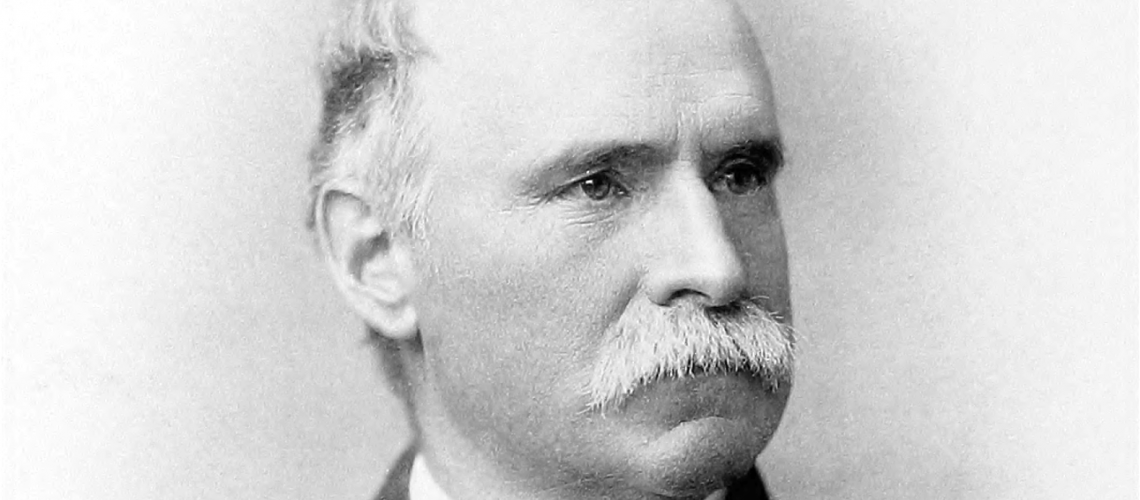Anthony J. Drexel
Anthony J. Drexel is significant in West Philadelphia’s history not only as the founder and namesake of Drexel University, but also as an expansive property owner, developer, and philanthropist.
Anthony J. Drexel, founder of what is today known as Drexel University, was a notable 19th-century Industrial Age financier. Drexel chose to establish his home in West Philadelphia and owned multiple additional properties in the area. Renowned for his philanthropy throughout Philadelphia, Drexel is most well-known for founding of the Drexel Institute of Art, Science, and Industry in 1891. His aim was to provide a practical education and a means of upward mobility for sons and daughters of the urban working class.
One of the nation’s most influential financiers in the decades after the Civil War, Anthony Drexel was the senior partner in the Philadelphia investment firm Drexel and Company (the House of Drexel), which Drexel’s father, Francis, an immigrant from the Austro-Hungarian Empire, had founded in 1847. In 1871, Anthony Drexel affiliated with the young J. Pierpont Morgan to form the New York-based investment bank Drexel, Morgan and Company, which, following Drexel’s death in 1893, was reorganized as J.P. Morgan and Company; the Morgan firm would finance the formation of the United States Steel Corporation, among other transformative corporate-industrial giants.[1]
Drexel himself continued to live and work in Philadelphia as the head of Drexel and Company, commuting daily on horseback from his home in West Philadelphia to the firm’s offices at Third and Chestnut Streets. He and his wife, Ellen Rozét Drexel, chose to distance themselves socially from the city’s blueblood families by residing in “WP,” the upper class’s pejorative moniker for the ethnically diverse area west of the Schuylkill (the elite character of Drexel’s neighborhood, notwithstanding). Drexel, despite his wealth, was the son of an immigrant and sometimes excluded from the traditional “old money” society of Philadelphia. Following the Civil War, Anthony and Ellen built, as their family home, an ornate, 45-room Italianate mansion on a large property—three quarters of the block bounded by 38th, 39th, Walnut, and Locust Streets—where they raised their nine children.[2]
On the Locust Street side of the “Drexel Colony,”[3] Anthony built mansions for two of his sons, George Childs Drexel and Anthony Drexel, Jr., which, in the 1960s, became part of Penn’s West Campus; architected in the Queen Ann style, Anthony Jr.’s mansion is now home to the Pi Phi Chapter of Sigma Chi fraternity; George’s neo-Georgian house now belongs to the Alpha Tau Omega fraternity. After Drexel’s death in 1893 (Ellen had died in 1891, just months before the Drexel Institute’s dedication ceremony), the family residence was acquired by the industrial philanthropist Samuel Fels, who replaced the Drexel mansion with one of his own, a neo-Georgian edifice at the corner of 39th and Walnut Streets, which he bequeathed to the University of Pennsylvania and is now home to the Fels Institute of Government.[4] Always an investor, Drexel owned a swath of undeveloped properties between Lombard (now Larchwood) and Spruce Streets from 46th to north of 47th—the heart of what, in the 1920s, became the Garden Court neighborhood.[5] Drexel also controlled two blocks of developed properties in the quadrant bounded by 43rd to 45th, Lombard (now Larchwood), and Osage Streets.[6]
Drexel was active in West Philadelphia religious affairs. Though the rest of the Drexel family were devout Catholics—his niece, Katherine Drexel (1858–1955), was canonized as a Catholic saint in 2000—Drexel converted to his wife’s Episcopalian faith. Drexel, his wife, and their nine children were members of the Church of the Savior, established in 1852 at 38th and Ludlow Streets, standing just a few blocks from the Drexel residence. Drexel held offices in this church for 37 years, first as a vestryman, later as accounting warden. “A glorious cycle of murals” located in the apse of the church honors his memory.[7]
Drexel’s founding donation to what would become West Philadelphia’s Drexel University was emblematic of his strong commitment to civic engagement. Mindful of his father’s immigrant roots and influenced by his progressive niece Katherine, Drexel wished to open economic opportunities for Philadelphia’s ethnic working class.[8] An article that appeared in Harper’s Weekly shortly after the Drexel Institute’s opening aptly summarized Anthony’s motives:
Its curriculum is such that when a young man or young woman goes forth from its doors with its diploma in hand, he or she may find a situation open and waiting. It will afford training—and that is practical education—to the masses, who have undoubted ability, but no possibility of attaining development under present scholastic conditions. The Drexel Institute starts upon a course of broad philanthropy, of which no man can consider the possible bounds.[9]
Outside West Philadelphia, Drexel and his closest friend, George W. Childs, who edited the Public Ledger, a newspaper in which Drexel and his brothers held the controlling shares, “built America’s first suburban development in Wayne, several miles beyond Bryn Mawr on the Main Line.”[10]
